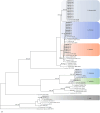Characterization and fungicides sensitivity of Colletotrichum species causing Hydrangea macrophylla anthracnose in Beijing, China
- PMID: 39906229
- PMCID: PMC11790641
- DOI: 10.3389/fpls.2024.1504135
Characterization and fungicides sensitivity of Colletotrichum species causing Hydrangea macrophylla anthracnose in Beijing, China
Abstract
Hydrangea macrophylla (Thunb.) Ser. is one of the widely cultivated plants in home gardens and scenic areas of China. Anthracnose disease is commonly observed during the normal growth of H. macrophylla, significantly impacting its ornamental and economic values. From 2021 to 2023, an investigation on H. macrophylla anthracnose was carried out in nine parks of Beijing, China, and a total of 114 Colletotrichum isolates were obtained from the diseased leaves with typical anthracnose symptoms. Based on morphological characteristics and phylogenetic analysis of six genomic loci including rDNA-ITS, ACT, TUB2, CAL, CHS-1, and GAPDH, these isolates were identified as belonging to six Colletotrichum species. Among which, C. gloeosporioides was the most abundant (65 isolates, 57.0%), followed by C. fructicola (33 isolates, 28.9%), C. aenigma (8 isolates, 7.0%), C. truncatum (4 isolates, 3.5%), C. subacidae (2 isolates, 1.8%) and C. sojae (2 isolates, 1.8%). Pathogenicity test conducted on detached leaves of H. macrophylla revealed a distinct variation in virulence among isolates from different Colletotrichum species, and wounding was either essential or conducive to successful infection. Specifically, C. gloeosporioides exhibited greater aggressiveness, resulting in larger lesions, while C. subacidae induced lesions most quickly. Fungicide sensitivity assays demonstrated that prochloraz exerted a remarkable inhibitory effect on the mycelial growth of representative isolates belonging to the three predominant Colletotrichum species. In contrast to difenoconazole and tebuconazole, the mean EC50 values for prochloraz against C. gloeosporioides, C. fructicola, and C. aenigma were 0.062, 0.033, and 0.023 μg/ml, respectively. This is the first report of C. aenigma, C. truncatum, C. subacidae and C. sojae causing H. macrophylla anthracnose worldwide including China. These findings have elucidated the Colletotrichum species associated with H. macrophylla anthracnose as well as their fungicides sensitivities in Beijing, China. This provides a scientific foundation for the accurate diagnosis and local management of H. macrophylla anthracnose.
Keywords: Colletotrichum species; Hydrangea macrophylla; anthracnose; fungicide sensitivity; multi-loci phylogeny.
Copyright © 2025 Zhao, Cheng, Liu, Shi, Zhang and Qin.
Conflict of interest statement
The authors declare that the research was conducted in the absence of any commercial or financial relationships that could be construed as a potential conflict of interest.
Figures




Similar articles
-
Anthracnose of Dendrobium brymerianum Caused by Colletotrichum fructicola and C. jiangxiense in Yunnan, China.Plant Dis. 2025 Jun 23. doi: 10.1094/PDIS-02-25-0289-PDN. Online ahead of print. Plant Dis. 2025. PMID: 40549451
-
Diversity of Colletotrichum species associated with anthracnose on Euonymus japonicus and their sensitivity to fungicides.Front Plant Sci. 2024 Jun 13;15:1411625. doi: 10.3389/fpls.2024.1411625. eCollection 2024. Front Plant Sci. 2024. PMID: 38938640 Free PMC article.
-
Characterization and fungicide sensitivity of Colletotrichum godetiae causing sweet cherry fruit anthracnose in Guizhou, China.Front Microbiol. 2022 Sep 27;13:923181. doi: 10.3389/fmicb.2022.923181. eCollection 2022. Front Microbiol. 2022. PMID: 36312935 Free PMC article.
-
Soybean anthracnose caused by Colletotrichum species: Current status and future prospects.Mol Plant Pathol. 2021 Apr;22(4):393-409. doi: 10.1111/mpp.13036. Epub 2021 Feb 20. Mol Plant Pathol. 2021. PMID: 33609073 Free PMC article. Review.
-
Signs and symptoms to determine if a patient presenting in primary care or hospital outpatient settings has COVID-19.Cochrane Database Syst Rev. 2022 May 20;5(5):CD013665. doi: 10.1002/14651858.CD013665.pub3. Cochrane Database Syst Rev. 2022. PMID: 35593186 Free PMC article.
References
-
- Aktaruzzaman M., Afroz T., Lee Y. G., Kim B. S. (2018). Post-harvest anthracnose of papaya caused by Colletotrichum truncatum in Korea. Eur. J. Plant Pathol. 150, 259–265. doi: 10.1007/s10658-017-1265-y - DOI
-
- Cai L., Hyde K. D., Taylor P., Weir B. S., Waller J. M., Abang M. M., et al. (2009). A polyphasic approach for studying Colletotrichum . Fungal Divers. 39, 183–204.
-
- Carbone I., Kohn L. M. (1999). A method for designing primer sets for speciation studies in filamentous ascomycetes. Mycologia 91, 553–556. doi: 10.1080/00275514.1999.12061051 - DOI
LinkOut - more resources
Full Text Sources
Research Materials

